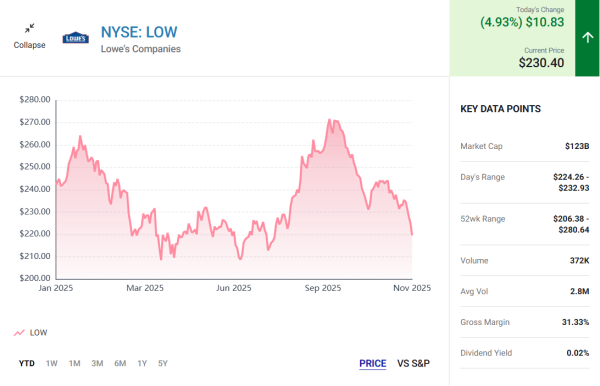Brokers from LFtrade have been closely analyzing the recent moves in the home improvement sector, and Lowe’s Companies (LOW) has captured their attention. After archrival Home Depot (HD) reported a disappointing earnings miss, Lowe’s earnings beat sent its stock soaring by 5.1% in early trading. This performance has prompted investors to ask whether Lowe’s represents a compelling buying opportunity or if caution is still warranted.

Lowe’s Q3 Earnings Beat Expectations
Analysts had forecasted that Lowe’s would report $2.95 per share in Q3 on sales of $20.84 billion, setting a moderate expectation for the home improvement retailer. The company exceeded earnings estimates, posting $3.06 per share, demonstrating resilience despite a slightly lower-than-expected $20.81 billion in sales.
While the non-GAAP profit figure was strong, the GAAP earnings of $2.88 per share reflected a nearly 4% decline from the prior year, largely driven by $129 million in pre-tax expenses associated with acquisitions of Foundation Building Materials (FBM) and Artisan Design Group (ADG). These strategic acquisitions are aimed at expanding Lowe’s footprint and enhancing its product offerings, suggesting that some of the short-term costs may pay off in the long term.
Despite the GAAP decline, Lowe’s achieved 0.4% same-store sales growth, which is twice the growth rate Home Depot reported in the same quarter, indicating that Lowe’s is outperforming its main competitor in comparable store performance.
Total sales growth of 3% further signals that the company is continuing to expand even in a challenging retail environment marked by shifting consumer behavior and ongoing supply chain pressures. Analysts note that Lowe’s ability to grow sales while managing acquisition-related costs demonstrates operational efficiency and a solid positioning in the home improvement sector.
Context Matters: Comparing Lowe’s to Home Depot
Lowe’s performance is particularly notable when compared with Home Depot’s results. Home Depot cited a lack of storms in the third quarter as a factor behind its weaker-than-expected outcomes.
Similarly, Lowe’s acknowledged that last year’s sales benefited from hurricane-related purchasing, which did not repeat this year, slightly pressuring results. Even with this headwind, Lowe’s still managed to outperform its larger rival, indicating strong operational execution..
Guidance Offers a Mixed Picture
Turning to guidance, Lowe’s raised its full-year sales forecast to $86 billion, signaling management’s confidence in top-line growth. However, the company lowered its same-store sales forecast to “flat” compared to 2024, reflecting a more cautious view of underlying demand.
Additionally, Lowe’s reduced its adjusted operating margin guidance and warned that full-year earnings would land near the low end of previous guidance, around $12.25 per share, adjusted for one-time items.
Guidance is a critical indicator of how management views the market environment. While growth prospects remain solid, the caution on margins and earnings suggests the company is preparing for continued cost pressures and modest consumer demand.
Valuation and Investment Outlook
Lowe’s currently trades at a price-to-earnings ratio under 19x, making it appear modestly cheaper than Home Depot, which has historically commanded a premium. This valuation has caught the attention of investors seeking exposure to the home improvement sector at a more attractive price. Brokers note that while Lowe’s appears relatively undervalued, the combination of slower same-store sales growth and margin pressure warrants a cautious approach.

Should You Buy Lowe’s Now?
The brokers’ analysis indicates that Lowe’s has a mixed investment profile. On one hand, the company continues to outperform its peers, deliver consistent sales growth, and expand market share through acquisitions. On the other hand, earnings guidance is soft, same-store sales are expected to remain flat, and operating margins face pressure, suggesting that Lowe’s stock may not have immediate upside.
Investors should weigh the potential long-term benefits of Lowe’s growth strategy against the near-term risks highlighted by management. The stock’s valuation is attractive, but brokers advise caution for those expecting rapid gains in the current retail environment.
Bottom Line
Lowe’s is delivering operational improvements and pursuing strategic acquisitions, but short-term headwinds limit the stock’s appeal as a buy right now. For long-term investors, Lowe’s may remain an attractive option, but the stock is likely still a sell for risk-averse traders seeking immediate returns.
In summary, Lowe’s beat earnings expectations, grew sales faster than Home Depot, and raised its revenue outlook. Yet soft guidance on margins and same-store sales growth temper enthusiasm. Investors should approach Lowe’s with a balanced perspective, recognizing both its relative strengths and lingering risks in the home improvement market.










